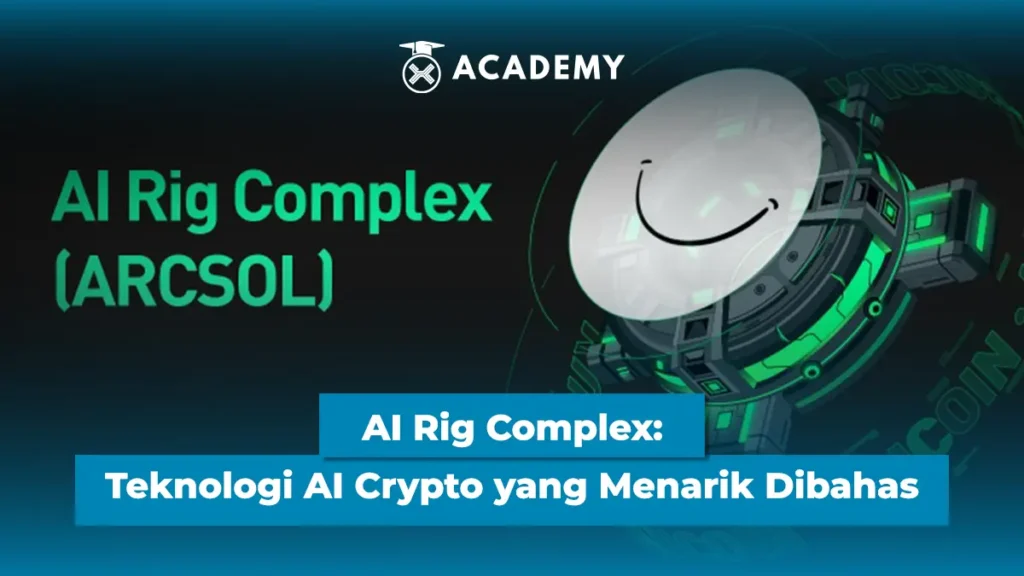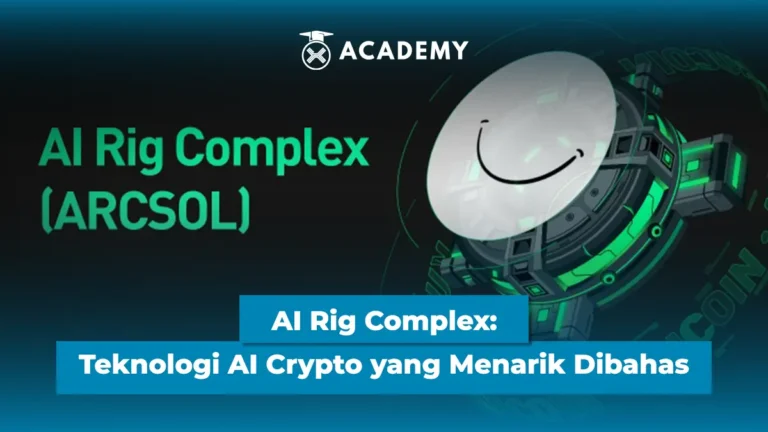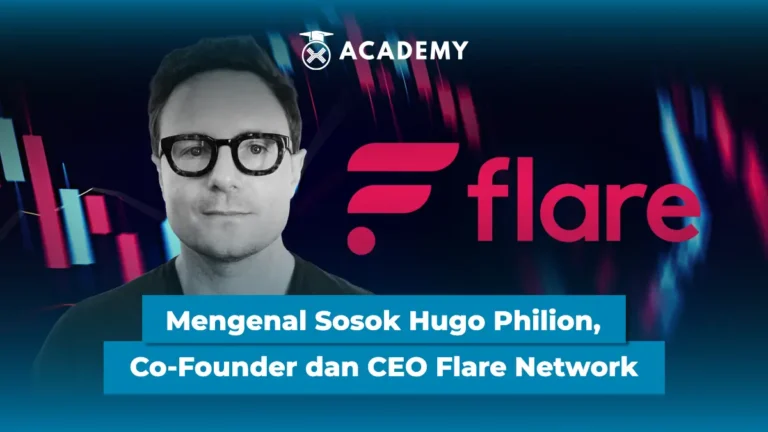AI + crypto projects have recently become a hot topic again, from the hype surrounding AI agents, the booming Solana ecosystem, to the emergence of ARC, which has immediately attracted attention.
Many are curious because ARC offers a unique concept: combining modular AI with blockchain technology in a single ecosystem that feels fresh and relevant to today’s Web3 developments.
With that background, we can begin to see what ARC really offers and why many consider it a new wave among AI + crypto projects.
What is AI Rig Complex (ARC)?
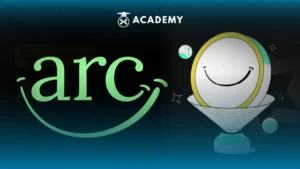
ARC is a project that seeks to unite the worlds of AI and blockchain through a simple approach: creating modular, portable, and lightweight AI agents. Not large, complex AI, but intelligent agents that can be built, configured, and run more easily, then connected to the blockchain ecosystem to work openly and transparently.
This platform functions as an open-source framework that helps developers create AI agents like “Lego components,” that is, they can be installed, removed, or expanded as needed.
With this concept, ARC opens the door to delivering flexible, efficient, and cross-platform AI applications, including those within various Web3 services.
ARC is essentially a foundation for creating more practical and easy-to-use AI agents, while leveraging blockchain technology to ensure everything runs securely and decentralized.
The Origins of AI Rig Complex and the Team Behind It
To understand ARC, it’s easiest to look at how the project began, its vision, and the technology that underpins it.
Background to ARC
ARC emerged because of a classic problem: AI agents are complex. Developers typically have to manage a lot of things from scratch, from infrastructure and AI model integration to how to connect them to the blockchain.
The ARC team saw that these technical barriers were actually hindering innovation. So they created a more streamlined framework that allows AI agents to be built and run without having to worry about heavy technical layers.
Background to ARC
ARC emerged from a classic problem: the complexity of AI agents. Developers typically have to manage many things from scratch, from infrastructure and AI model integration to connecting them to the blockchain.
The ARC team saw that these technical barriers were actually hindering innovation. So they created a more streamlined framework where AI agents could be built and run without having to worry about heavy technical layers.
Vision for Developing AI Protocols in a Web3 Environment
ARC envisions that future AI should operate openly, securely, and decentralized.
They want AI agents to be able to interact directly with blockchain networks, for example, analyzing on-chain data, running automated tasks, or executing DeFi transactions.
This way, Web3 will not only be a place to store digital assets, but also a space where AI can become autonomous and trustworthy “workers.”
Technology Focus (Rust + Solana + Modular AI)
To realize this vision, ARC is built with a combination of efficient and modern technologies. Rust was chosen because it is fast and secure, suitable for building lightweight and stable AI systems.
Integration with Solana enables high performance and low cost, two key attributes for continuously running AI applications.
Meanwhile, the modular AI concept allows developers to build agents like assembling components, making them more practical, flexible, and easily updated.
Through this combination, ARC aims to simplify the process of building AI agents so that anyone can focus on innovation rather than grappling with technical complexity.
How Complex AI Technology Works
To understand why ARC is gaining so much buzz, here’s a look at the core of the technology: how AI agents are built, how the framework works, and the role of blockchain in the entire ecosystem.
The Concept of AI Agents
ARC relies on lightweight AI agents tasked with performing a specific role, such as reading data, analyzing market conditions, or executing automated instructions.
These agents are not large or complex, but are designed as intelligent and efficient “little workers,” capable of understanding context through the integration of various AI models and vector databases.
Modular and Portable Framework
ARC provides a modular, Rust-based foundation that can be assembled like Lego, so developers don’t have to build everything from scratch.
This approach makes agents lightweight, fast, and easily portable to various environments, whether cloud, on-chain, or at the edge. As a result, building AI-based dApps is much simpler and minimizes boilerplate (template code).
The Role of Blockchain in ARC
Blockchain provides a layer of coordination and transparency. Through the ARC protocol, agents can operate without a centralized server, with activity recorded and rules automatically enforced.
ARC tokens act as fuel, providing access to features, payment for services, and governance.
ARC’s Relationship with Solana
Solana was chosen for its speed and low fees, two crucial factors for continuously active AI agents.
The ARC ecosystem leverages the AVM that runs efficiently on Solana, enabling real-time execution for applications like DeFi, trading, and on-chain gaming.
ARC Tokens and Their Functions
ARC tokens are the “fuel” that powers the entire AI Rig Complex ecosystem, but their role is less for investment and more as a utility component that ensures the AI ??agents’ operation and the ecosystem’s viability.
The ARC token’s role in the ecosystem
ARC is used as a transaction tool within the protocol, from accessing AI features to supporting the operation of various applications built on it.
These tokens also serve as an incentive mechanism to reward developers and contributors who improve models, add features, or build new projects.
In addition, ARC is used in governance, where token holders can influence the direction of protocol development.
Basic Use Cases (Access to Agents, Resources, Technical Utility)
ARC serves as a ticket to use AI resources, for example, unlocking access to specific agents, using premium models, or running computationally demanding technical features.
Every interaction within the ecosystem, from model invocation to integration with external LLMs, is linked to this token.
The goal is simple: to make the experience of building and using AI agents more streamlined and structured.
How does the token relate to the AI ??ecosystem?
ARC’s position is quite central; every project launched through ARC Forge uses ARC as a liquidity route and base fee.
This means that activities within the ecosystem, such as agent interactions, new token launches, or the operation of AI dApps, automatically create utility demand for the token.
In other words, ARC is not a standalone element, but is directly connected to how AI agents are built, run, and used by users.
As a side note, the ARC token is not currently available on Indodax, so Indonesian traders interested in learning about the project will need to access information from global markets without a purchase orientation.
Key Features of AI Rig Complex
ARC is attracting attention because it offers a simpler and more efficient way to build AI agents in the Web3 ecosystem. These four features are the main reasons:
Customizable AI Agents
As an open-source framework, ARC makes it easy for developers to create AI agents tailored to their needs, from market analysis to automated transaction execution.
Support for a variety of major LLMs and minimal boilerplate (standard code/configuration that is often rewritten when building applications) significantly speed up the development process.
Modular and Lightweight for Developers
The Rust-based architecture and support for technologies like the ARC Virtual Machine make the agents lightweight and fast to run.
Integration with embedding workflows (converting data into vectors), vector databases (based on vectors), and multi-agent systems (collaborative agents) adds flexibility without burdening developers.
Open-Source Ecosystem
ARC grows through community contributions. The Handshake program and ARC Forge encourage new projects to join the ecosystem, while the ARC token is used as an incentive for contributors.
With tens of thousands of token holders, the community is active and growing.
Potential for Other Web3 Integrations
ARC is designed to easily connect with various networks like Solana, Ethereum, and Arbitrum.
Features like Smart Order Routing demonstrate multi-chain capabilities, opening up opportunities for smarter and more autonomous AI-based dApps.
ARC itself is attracting the attention of developers and the community because it offers a complete package: modular, high-performance AI, easy to use, and ready to integrate into various Web3 ecosystems.
Developers save time, the community sees great potential, and the result is that ARC has become one of the most talked-about AI + crypto projects of recent times.
What are the Advantages of AI Rig Complex?
ARC is a project that aims to bridge the worlds of AI and blockchain in a more practical way. Several advantages make this protocol attractive to developers and the Web3 community, including the following:
Focus on Flexible AI Agents
ARC provides a framework for building AI agents that can be customized to suit your needs, from chatbots to market analysis agents.
Support for various LLM providers and vector databases gives developers more freedom to choose the most suitable models and workflows without being restricted to a specific ecosystem.
Fast and Efficient Rust Architecture
Because it is built with Rust, ARC offers high performance and strong memory safety.
This combination is useful for creating lightweight yet responsive AI agents, further enhanced by the ARC Virtual Machine (AVM), which is designed to be much faster than similar VMs.
Portable Technology: Can be used across systems
One of ARC’s added values ??is its portability. This framework supports integration with many AI services, data stores like MongoDB or Neo4j, and blockchain networks like Solana, Ethereum, and Arbitrum.
As a result, AI agents built on ARC can run in a variety of environments without requiring heavy reconfiguration.
Open-source support accelerates innovation
With its open-source approach, ARC allows anyone to contribute to feature development and system improvements.
Programs like Handshake and ARC Forge help expand the ecosystem by encouraging new projects. The ARC token is then used as an incentive mechanism to ensure continued innovation.
Risks and Challenges of a Complex AI Rig
While ARC offers an interesting approach to combining AI and blockchain, the project still carries a number of risks that need to be understood, including:
Risks of Emerging Technology
ARC relies on emerging technologies, ranging from AI agents and memory-based vector databases to the claimed super-fast AVM.
None of these have been fully tested at scale, so the potential for bugs, instability, or security vulnerabilities remains a concern.
Challenges of Adopting AI Agents in Web3
While ARC simplifies the process of building AI agents, integrating them into the Web3 world remains challenging.
Developers must understand both AI and blockchain, while users may not immediately trust AI agents capable of executing automated actions. Regulatory ambiguity further slows adoption.
Fierce Competition in the AI ??+ Crypto Sector
The AI-crypto ecosystem is teeming with new players, from projects building AI agents to faster on-chain execution engines.
ARC must demonstrate real advantages and strengthen the community to avoid being overtaken by more mature or more innovative projects.
ARC Token Volatility Risk
The ARC token plays a vital role in the ecosystem, but it remains a highly volatile market. Rapid price changes can be influenced by sentiment, project development, and competition.
Users also need to understand that technological progress does not always translate directly to price movements.
Is AI Rig Complex Still Active in 2025?
In 2025, AI Rig Complex (ARC) remains relatively active. The ARC token continues to trade with fairly stable daily volume.
The project is also still receiving updates, from smart contract updates to additional support for Rust and WebAssembly-based AI agents. This activity indicates that development has not stopped.
However, ARC cannot yet be considered a well-established project. Its market capitalization and liquidity are still small, making it more appropriate to view it as a developing project, rather than a mature one.
Essentially, ARC is still active and moving forward, but it is not yet fully stable. This makes it interesting to monitor, but still requires a cautious approach.
How to Get Started or Try AI Rig Complex
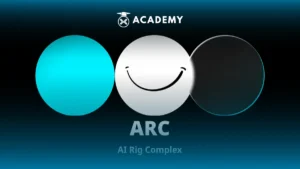
If you’re curious about ARC but aren’t ready to dive into the technical side of things, here are some easy steps to get started with the project without risk:
How to check the official website & documentation
You can start by visiting the official ARC website and documentation. This section usually contains a basic overview of the modular AI concept, an explanation of the AI ??agent workflow, and simple implementation examples.
The documentation also helps you understand how ARC works without having to delve directly into the technical aspects.
How to understand AI agents without coding
To understand AI agents without writing code, simply focus on the concept: ARC creates agents that can perform automated tasks such as reading data, executing commands, or interacting with blockchain protocols.
Explanations about AVMs, LLM integration, and memory-based vector databases are usually presented in a way that is easy for general users to understand.
Things to check before interacting
Because ARC is still under development, some of its features are subject to change.
Make sure you always access the correct official website or repository, read updates from the team, and understand the limitations of technologies such as on-chain AI agents, which are still evolving.
Safety tips for beginners
You should not connect your wallet to any platform before verifying its origin, avoid experimental features on the main network if you don’t understand the risks, and use a testnet if available.
These steps will help you learn ARC gradually and safely, without the need for technical involvement.
Conclusion
So, that was an interesting discussion about AI Rig Complex, a curious crypto AI project, which you can read more about in the INDODAX Academy crypto academy.
In conclusion, ARC is interesting not only because of the hype, but also because of its distinct approach to building blockchain-based AI agents.
The modular and open concept it offers offers a fresh perspective on how AI can thrive in the Web3 ecosystem.
However, this project is still in its early stages, so it’s important to understand the context, risks, and development direction before jumping in. ARC has potential, but it still needs to be approached wisely.
By the way, in addition to gaining in-depth insights through various popular crypto education articles, you can also broaden your horizons through a collection of tutorials and choose from a variety of popular articles that suit your interests.
Besides updating your knowledge, you can also directly monitor digital asset prices on Indodax Market and stay up-to-date with the latest crypto news. For a more personalized trading experience, explore Indodax’s OTC trading service. Don’t forget to activate notifications so you don’t miss out on important information about blockchain, crypto assets, and other trading opportunities.
You can also follow our latest news via Google News for faster and more reliable access to information. For an easy and secure trading experience, download the best crypto app from INDODAX on the App Store or Google Play Store.
Maximize your crypto assets with the INDODAX Earn feature, a practical way to earn passive income from your stored assets. Register now with INDODAX and easily complete KYC to start trading crypto more safely, conveniently, and reliably!
Indodax Official Contact
Customer Service Number: (021) 5065 8888 | Support Email: [email protected]
Also follow us on social media here: Instagram, X, Youtube & Telegram
FAQ
1.What is the main function of the ARC token?
To support technical utilities in the AI ??agent ecosystem.
2.Can ARC be used without understanding AI technicalities?
Yes, because the framework is modular and beginner-friendly.
3.Is ARC a new project?
Yes, ARC is still developing and in its early stages.
4.Does AI Rig Complex have a real use case?
Yes, especially for AI developers who want to create modular agents.
5.Is AI Rig Complex suitable for beginners?
It’s suitable for learning the concept of AI agents, not for token speculation.
Author: Boy




